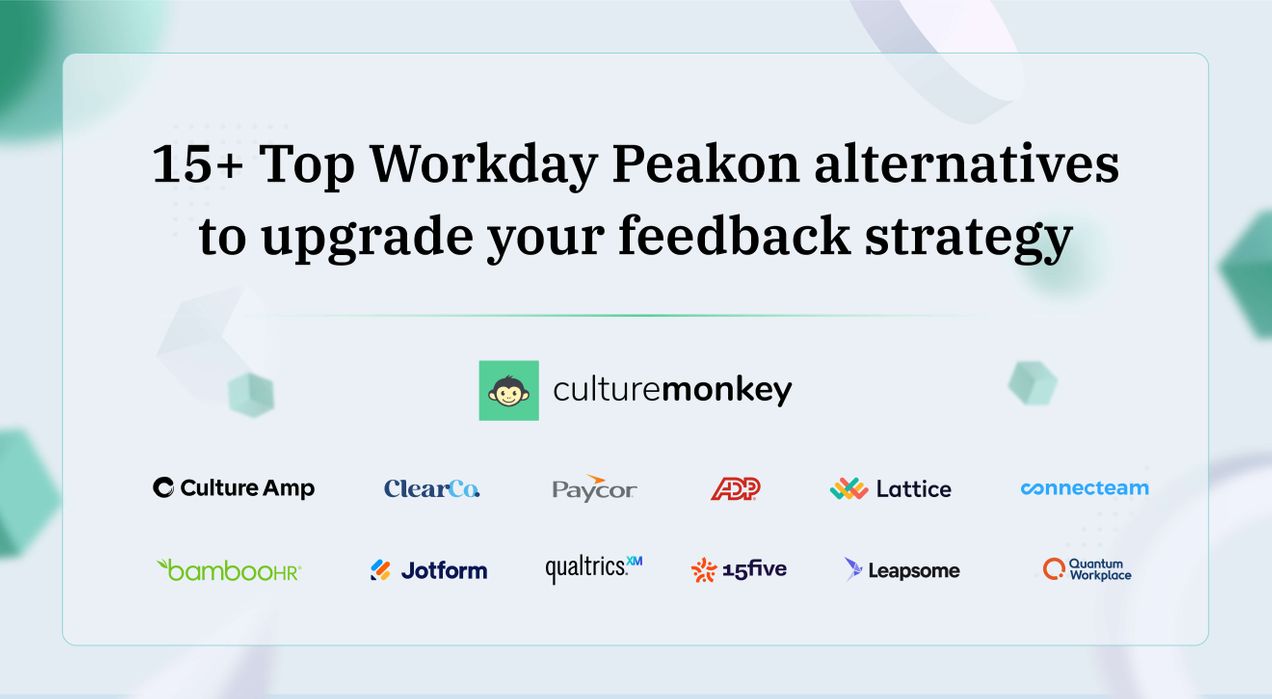Employee engagement survey benchmark data: A complete guide for leaders in 2025

Imagine running a sports team without knowing the score. You could be winning, losing, or somewhere in between—but without the numbers, it’s just guesswork. The same applies to employee engagement.
Benchmark data gives leaders that crucial scoreboard, revealing where their team stands compared to industry standards and competitors. It’s not just about collecting feedback—it’s about understanding the context, spotting gaps, and identifying exactly what drives improvement.
Now relying on instincts alone isn’t enough. This guide will walk you through the latest employee engagement survey benchmarks, so you can make informed, impactful decisions that keep your workforce motivated, connected, and performing at their best.
TL;DR
How to measure employee engagement with surveys the right way?

TL;DR
Define a clear survey objective, mix quantitative and open-ended questions, and keep it concise to avoid fatigue. Ensure anonymity to encourage honest feedback and use a consistent rating scale for comparability.
Run surveys regularly—quarterly pulse checks work best—and always act on results. Closing the loop with visible changes boosts trust, engagement, and survey participation over time.
Measuring engagement isn't about throwing random questions into a form and hoping for the best. It’s about building surveys that surface insights you can actually use. Here's how to make sure you're doing it right—with accuracy, clarity, and alignment to your goals.
Start with a clear purpose
Before sending out your survey, define what you're trying to learn. Are you looking to improve team morale, understand retention risks, or benchmark performance? A clear objective shapes better questions, leading to a higher average score and giving structure to your employee engagement survey benchmark data.
Ask the right questions
Use a mix of quantitative and open-ended questions to get both metrics and context. Focus on areas like communication, leadership, recognition, and growth opportunities to gather key insights, core drivers of engagement. Avoid vague questions that don’t lead to actionable insights.
Keep it short and sharp
A long survey leads to fatigue and half-hearted answers. Aim for a completion time of under 10 minutes. Well-crafted surveys that respect your employees’ time usually receive more valuable insights and thoughtful responses.
Ensure anonymity
To get real answers, employees need to feel safe. Make it crystal clear that responses are anonymous. This builds trust and gives you more authentic input, especially when evaluating sensitive topics like management or culture.
Use a consistent rating scale
Whether you choose a 5-point or 10-point scale, keep it consistent throughout. Consistency makes it easier to analyze trends and compare responses across different teams when diving into employee engagement survey benchmark data.
Run surveys regularly
One survey a year won’t cut it. Run pulse surveys quarterly (or at least bi-annually) to track changes and spot red flags early. This creates a rhythm of listening that keeps engagement on your radar all year long.
Close the loop with action
Surveying is step one. What you do after sharing employee engagement survey results, addressing concerns, and taking visible action is what drives change. Engagement improves when employees see their survey responses being acknowledged and acted on.
What are employee engagement benchmarks?

Benchmarks are like the scoreboards of employee engagement—they show how your team’s experience stacks up against others in your industry or region. But they’re more than just numbers; they offer crucial context for understanding performance outcomes. Let’s break down what employee engagement benchmarks really mean and why they matter.
- Standardized comparison metrics: Employee engagement benchmarks give you standardized data to compare your team’s engagement levels with others in similar sectors or company sizes. This helps you understand if your engagement levels are lagging or leading the curve.
- Based on large-scale survey data: These benchmarks are pulled from massive databases, often from organizations like Gallup or SHRM, that collect and analyze thousands of employee survey benchmarks globally. This wide data set brings more reliability to your insights.
- Help identify strengths and weaknesses: When you match your employee engagement survey benchmark data against industry norms, it highlights your high-performing areas and uncovers the ones that need attention. It's like holding up a mirror to your engagement strategy.
- Guide goal-setting and improvements: Benchmarks aren’t just reflective, they’re directional. They help in setting realistic engagement goals and tracking improvement over time. You can define progress not just by internal movement but by how you’re catching up (or outpacing) your peers.
- Useful across departments and roles: You can apply employee engagement score benchmarks across departments to see which teams are thriving or struggling. It’s especially useful when managing multiple functions or locations, as you can localize your engagement strategies effectively.
Why is employee engagement benchmarking important?

TL;DR
Benchmarks provide context, showing if your engagement score is strong or weak compared to industry peers. They highlight competitive gaps and guide targeted improvements.
They also help secure leadership buy-in, track measurable progress, and align culture with business goals. Benchmarking transforms raw survey data into actionable, comparative insights for long-term engagement strategy.
Engagement scores don’t mean much in isolation. Without comparison, a 70% score could either be great or deeply worrying. That’s where employee engagement benchmarking becomes essential—it gives your data context, direction, and meaning.
- Puts your data in perspective: Without benchmarks, you’re shooting in the dark. Comparing your numbers to employee survey benchmarks helps you understand whether your engagement levels are actually healthy—or just average.
- Identifies competitive gaps: Benchmarking exposes where you might be falling short compared to industry standards. This helps leaders focus on areas that are affecting retention, morale, or performance and refine strategies accordingly.
- Supports executive buy-in: It’s easier to rally leadership around engagement efforts when you have hard numbers that show where you stand. Benchmarking gives your case the credibility it needs for budget approvals and cross-team collaboration.
- Tracks improvement meaningfully: Monitoring progress against employee engagement survey benchmark data helps you determine if your engagement initiatives are working. It’s not just about internal change—it’s about measurable, comparative improvement.
- Drives strategic decision-making: Engagement benchmarking helps prioritize interventions. Whether you’re redesigning onboarding, improving leadership training, or enhancing internal comms—it guides you to act where it matters most.
- Aligns culture with business goals: Consistent benchmarking ensures your engagement efforts aren’t operating in a silo. When your culture aligns with industry expectations and trends, you’re in a stronger position to retain talent and scale sustainably.
Types of employee engagement data benchmarks
TL;DR
Internal benchmarks track progress against your past performance, while external benchmarks compare you to industry, size, or region averages. Demographic benchmarks uncover hidden disengagement within subgroups.
Global benchmarks reveal international patterns, and score-based metrics like eNPS offer easy cross-team comparisons. Combining all gives a full, nuanced view of engagement strengths and weaknesses.
Not all benchmarks are created equal. To gain a comprehensive understanding, you need to grasp the various types of engagement data benchmarks and how each one serves a distinct role in decision-making for employees worldwide. Here's a breakdown of the key types you’ll want to track.
- Internal benchmarks: These compare your current engagement scores to your own past results. Tracking trends over time reveals what’s improving, what’s slipping, and how your engagement strategies are evolving. It's the most personal form of employee engagement benchmark data.
- External/Industry benchmarks: This is where employee engagement survey benchmark data really shines. It compares your data to industry peers, company size, or regional averages—helping you understand where you stand in the larger ecosystem.
- Demographic benchmarks: These benchmarks break down scores by employee demographics like department, tenure, role, or age. It helps uncover hidden pockets of disengagement and allows targeted improvements that actually resonate.
- Global benchmarks: Pulled from large-scale databases like SHRM or Gallup, employee survey benchmarks on a global scale show broader engagement patterns. Ideal for multinational companies or those planning to scale internationally.
- eNPS and score-based benchmarks: Benchmarks based on employee engagement score benchmarks, such as eNPS (employee Net Promoter Score) or engagement indices, make it easier to compare quantitative scores across teams, companies, or timeframes.
What impacts employee engagement benchmark data?

TL;DR
Survey design, timing, and internal changes can skew results. Context matters—industry norms, leadership quality, and cultural expectations all influence benchmark interpretation.
External events and employee trust in the survey process also shape data accuracy. Always assess benchmarks in light of recent organizational or market shifts to avoid misreading trends.
Benchmark data isn’t static—it’s influenced by everything from how you ask questions to what’s happening in the world outside your office walls. To interpret employee engagement survey benchmark data correctly, you need to understand what shapes it. Here are the major factors that might differ from other organizations.
- Survey design and timing: The structure, tone, and timing of your survey affect how people respond. A poorly timed survey (say, right after layoffs or year-end reviews) can skew results and distort your employee survey benchmarks.
- Organizational changes: Mergers, leadership shifts, or sudden policy changes can dramatically affect engagement. When comparing employee engagement benchmarks, consider what internal events may have influenced your team's mindset.
- Industry trends and norms: What’s considered “good” engagement varies by industry. Tech may expect higher flexibility scores, while manufacturing might prioritize safety and communication. Always contextualize your employee engagement score benchmark accordingly.
- Leadership behavior: The quality of leadership plays a huge role in how employees feel day-to-day. Poor communication, lack of transparency, or weak recognition practices can pull down your engagement metrics across the board.
- Cultural and regional factors: Workplace expectations vary globally. A 70% engagement score in one region might be stellar, while average elsewhere. Global employee engagement benchmark data must account for cultural nuances to be meaningful.
- Survey fatigue or mistrust: If employees don’t believe anything will change, they may not engage with surveys at all, or respond honestly. This directly impacts your employee engagement survey benchmark data and the accuracy of insights you rely on.
Top tips and best practices for collecting and using engagement benchmark data
Collecting engagement data is just the beginning—how you manage and apply it is where the magic happens. Done right, employee engagement survey benchmark data becomes a strategic asset, not just another HR report. Here’s how to make it work and push the organization forward.
- Use standardized survey formats: Stick to consistent question phrasing, rating scales, and delivery methods. This ensures your data is clean, comparable, and aligned with wider employee survey benchmarks.
- Segment data by team or demographic: Slice and dice your results by department, location, or tenure. It helps you understand where engagement is thriving, and where it’s silently slipping, relative to employee engagement score benchmarks.
- Compare against the right benchmarks: Choose industry-relevant, company-size-appropriate, or region-specific benchmarks. Using mismatched employee engagement benchmarks can lead to false assumptions and poor decisions.
- Watch trends over time: Don’t obsess over single survey results. Look at patterns across multiple quarters to identify steady growth, concerning dips, or stagnant areas within your employee engagement survey benchmark data.
- Act quickly on insights: Benchmarking means nothing without follow-up. Share findings transparently and implement improvements where needed. Speedy action builds trust and validates the survey process.
- Communicate results clearly: Translate data into stories—use visuals, summaries, and examples. This helps stakeholders across the company understand the meaning behind the employee engagement benchmarks and buy into next steps.
- Re-benchmark regularly: Set a rhythm for re-measuring engagement every 6–12 months. Frequent updates help you stay aligned with evolving trends in both your company and external employee survey benchmarks.
What is the benchmark response rate for an employee engagement survey?

The benchmark response rate for an employee engagement survey typically ranges between 70% and 85%, depending on the organization’s size, culture, and how the survey is communicated. A response rate below 60% often signals low trust, poor communication, or survey fatigue—issues that can also influence your overall employee engagement survey benchmark data.
High response rates matter because they improve the accuracy and reliability of your insights. If only a small slice of your workforce is responding, the results can’t truly represent the engagement levels across the board. That’s why one of the best practices in benchmarking is to not just track engagement scores, but also to benchmark response rates themselves.
Your employee survey benchmarks aren’t just about how engaged employees feel; they also reflect how much they care about being heard. Strong participation often aligns with higher employee engagement score benchmark performance, because when workers feel their feedback matters, they’re more likely to give it.
Global benchmarks: Gallup, SHRM & Hive 2024‑25 data
Based on recent data from Gallup, SHRM, and Hive, these global workplace benchmarks for 2024‑25 include the direct source alongside each statistic:
- Global employee engagement: According to Gallup, Only 21% of employees worldwide are engaged at work.
- Employee wellbeing: Just 33% of employees say they are thriving in life (Gallup).
- Culture favorability: SHRM reports that only 17% of employees rate their workplace culture as excellent.
- Economic cost of disengagement: Gallup reports that disengagement results in a $438 billion loss in global productivity each year.
Interpreting benchmarks: Percent favourable vs eNPS vs Index scores

When it comes to understanding employee engagement survey benchmark data, not all metrics speak the same language. From percent favourable to eNPS to index scores, each tells a different story. Here’s how to interpret them without getting lost in the numbers.
- Percent favourable: This metric shows the percentage of employees who responded positively to a question, usually by selecting the top one or two options on a scale. It’s widely used in employee engagement benchmarks because it’s easy to understand and compare across questions, teams, or even industries.
- eNPS (Employee Net Promoter Score): eNPS asks one question: “How likely are you to recommend your company as a place to work?” It categorizes responses into promoters, passives, and detractors, producing a score from -100 to +100. While eNPS is useful for high-level comparisons, it shouldn’t replace deeper employee engagement score benchmark analysis.
- Engagement index scores: These are calculated averages across several engagement-related questions. Often used in employee survey benchmarks, they offer a single score that reflects overall engagement health. Index scores are especially helpful for tracking changes over time or comparing across business units.
How to measure employee engagement KPIs?
TL;DR
Clarify what “engagement” means for your organization, then select measurable KPIs like eNPS, retention, and productivity. Link them directly to business outcomes for ROI clarity.
Use both pulse and annual surveys to balance immediacy with depth, track KPI trends over time, and act transparently on results to strengthen future engagement and benchmark accuracy.
KPIs turn your employee engagement efforts from fuzzy feelings into measurable outcomes. They help leaders track progress, set goals, and make smarter decisions. Here’s how to measure KPIs in a way that aligns with your employee engagement survey benchmark data.
- Define what engagement means for your organization: Before measuring anything, clarify what “engagement” looks like for you. It could be enthusiasm for work, loyalty, collaboration, or innovation. This definition will shape the right KPIs and tie directly to your employee engagement benchmarks.
- Choose the right metrics: Common engagement KPIs include participation rate, eNPS, retention rates, and productivity levels. Make sure your selected KPIs can be tracked consistently over time and compared against employee engagement score benchmarks.
- Link KPIs to business outcomes: Correlate engagement data with performance, absenteeism, or turnover rates. When KPIs tie back to business impact, it’s easier to justify engagement investments and track ROI across employee survey benchmarks.
- Use pulse and annual surveys together: Combine frequent pulse surveys with deeper annual ones to get both short-term and long-term insights. This blended approach keeps your employee engagement survey benchmark data current and contextual.
- Monitor KPI trends over time: Don’t just look at one-time numbers. Track engagement KPIs monthly, quarterly, or annually to identify trends, seasonality, and early warning signs of disengagement.
- Share results and take action: Once KPIs are measured, communicate the results transparently. Employees engage more when they see their input shapes real decisions—closing the loop strengthens future employee engagement benchmarks.
Using CultureMonkey for employee engagement benchmarking and optimization

Collecting feedback is only half the job—turning it into action is where CultureMonkey shines. This platform doesn’t just gather data; it helps you benchmark, interpret, and improve engagement strategically. Here’s how CultureMonkey supports data-driven engagement decisions.
- Real-time benchmark comparisons: CultureMonkey provides live comparisons of your engagement scores against industry-specific employee engagement benchmarks. It shows you where you stand and helps identify exactly where improvement is needed—without the guesswork.
- AI-powered survey insights: Its AI engine analyzes open-text feedback and quantitative data to surface patterns. This empowers HR teams to make informed decisions, backed by clean, structured employee engagement survey benchmark data.
- KPI dashboards for tracking engagement: The platform offers dynamic dashboards to monitor your engagement KPIs and employee engagement score benchmark trends over time. Visuals make it easy for leadership to spot dips and improvements at a glance.
- Customized benchmarking by team or location: You can filter your employee survey benchmarks by departments, locations, or functions, giving you context-rich insights and enabling targeted action where it matters most.
- Feedback loop and action tracking: CultureMonkey helps close the feedback loop with built-in action planning and tracking tools. That means your employee engagement survey benchmark data isn’t just measured, it’s mobilized.
Conclusion
Benchmarking isn’t just about comparing scores—it’s about understanding your people better and building a more engaged, motivated workplace. When used thoughtfully, employee engagement survey benchmark data helps you make smarter decisions, spot hidden issues, and track the real impact of your efforts over time.
Whether you’re setting goals, evaluating KPIs, or simply checking how your team stacks up, benchmarks provide the direction you need. But the real value comes when insights lead to action, and that’s where many companies fall short.
If you’re looking for a smarter way to collect, analyze, and act on your employee engagement feedback, CultureMonkey does the heavy lifting for you. Benchmark better, listen louder, and engage smarter—with CultureMonkey by your side.
Summary
FAQs
1. What is benchmark data in employee engagement?
Benchmark data in employee engagement refers to standard scores or metrics used to compare your organization’s engagement levels with others. It helps identify strengths, weaknesses, and areas needing attention. These comparisons can be based on industry, company size, or geography, allowing organizations to assess whether their engagement scores are above, below, or on par with similar entities.
2. What is the global engagement benchmark?
The global engagement benchmark typically refers to the average employee engagement score across industries worldwide. According to SHRM data, this usually ranges between 20% to 35% of employees being fully engaged. These benchmarks help organizations understand how their teams perform on a global scale and offer a broader context to interpret internal engagement results effectively.
3. How often should we benchmark our scores?
Benchmarking engagement scores should be done at least annually, with quarterly pulse surveys in between for real-time insight. Frequent benchmarking allows companies to track progress, spot shifts in sentiment, and make agile improvements. Comparing results regularly ensures engagement strategies stay aligned with employee expectations and external employee engagement survey benchmark data.
4. Which industry has the highest engagement?
Industries like professional services, tech, and healthcare often report the highest engagement levels. These sectors tend to offer more flexibility, growth opportunities, and recognition, which are key drivers of engagement. Benchmarking against these industries helps companies set aspirational goals and refine their approach to match high-performing employee engagement standards.
5. How does low engagement impact profit?
Low engagement directly affects productivity, innovation, and retention—leading to increased costs and lost revenue. Disengaged employees are less motivated, contribute less, and are more likely to leave, driving up turnover expenses. According to Gallup, companies with low engagement can experience up to 21% lower profitability compared to those with strong engagement.



